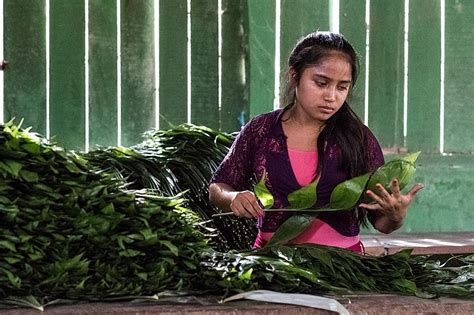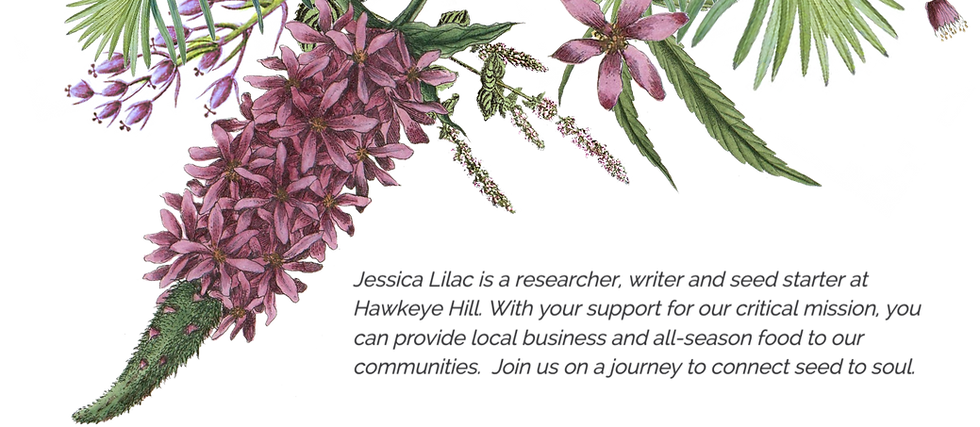To be a good citizen of this planet is to have concern for our own quantity and quality of consumption - in our bodies and from the Earth.
If you think that making better choices about what companies you support will not change the world, you’re wrong. It makes an impact. If you buy the same thing week after week or month after month from a rainforest certified, fair trade or organic company, you are paying their bills so they can continue to supply you with those high-quality products.

You are diverting thousands of dollars of cash a year from multi-million-dollar companies that don’t give their workers the basic human rights of fair pay or decent working conditions. They don’t always care about the environment or if we get cancer from the additives in their products. In fact, even their safety regulations set by government and non-government agencies, in many cases, are proving to be too low without adequate study.
Where something has been made, how can the carbon footprint be reduced, is there a local option, with less chemical ingredients? Could you stand to lose a little convenience in order to search for a product locally instead of Amazon?
There is the quick and rising concern that eco-friendly ideas have created a whole exercise in greenwashing. It’s true, not all fair trade or organic is created equal.
There are many organizations that certify a product to be “Fair Trade” but with different designations. Here’s the good, better, best.

BEST = "Rainforest Alliance Certified":
"The Standard encompasses all three pillars of sustainability—social, economic, and environmental.
Rainforest Alliance Certified™ farms are audited regularly to verify that farmers are complying with the Standard’s comprehensive requirements, which require continual improvement on the journey to sustainable agriculture. The Standard is built on these important principles of sustainable farming:
Biodiversity conservation
Improved livelihoods and human well-being
Natural resource conservation
Effective planning and farm management systems
Proprietors of tourism businesses, lodging services and inbound tour operators, who demonstrate they are minimizing their environmental footprint and supporting workers, local cultures, and surrounding communities may also be eligible for using the Rainforest Alliance Certified seal. Third-party audits and certification by NEPCon confirm these businesses meet tourism criteria, which are recognized by the Global Sustainable Tourism Council.
The criteria require:
Protection of nearby ecosystems
Wise use of natural resources
Climate change mitigation
Benefits to the social and cultural development of surrounding communities
The Rainforest Alliance is one of the founding members of the Forest Stewardship Council® (FSC®), the largest sustainable forestry standard setter in the world. Products that bear the FSC mark and the Rainforest Alliance

Certified seal are sourced from forests that:
Protect endangered species and forest areas of high conservation value
Set aside a portion of land as forest reserve
Provide workers with decent wages and protect their ability to organize
Follow FSC guidelines that determine how, when, and where timber and non-timber forest products are harvested
Respect the rights of local communities and indigenous people”
Reference: www.rainforest-alliance.org
BETTER = “Fairtrade”:
When you buy products with the FAIRTRADE Mark, you support farmers and workers as they work to improve their lives and their communities. The Mark means that the Fairtrade ingredients in the product have been produced by small-scale farmer organizations or plantations that meet Fairtrade social, economic and environmental standards.

The standards include:
Protection of workers’ rights and the environment
Payment of the Fairtrade Minimum Price
Additional Fairtrade Premium to invest in business or community projects.
Fairtrade works to benefit small-scale farmers and workers, who are amongst the most marginalized groups globally, through trade rather than aid to enable them to maintain their livelihoods and reach their potential.
For certain products, such as coffee, cocoa, cotton and rice, Fairtrade only certifies small-scale farmer organizations. Working through democratic organizations of small-scale farmers, Fairtrade offers rural families the stability of income which enables them to plan for the future.

For some products such as bananas, tea and flowers, Fairtrade also certifies plantations - companies that employ large numbers of workers on estates. Our Standards for such large-scale production units differ and protect workers’ basic rights; from keeping them safe and healthy, allowing them freedom of association and collective bargaining, to preventing discrimination and ensuring no bonded or illegal child labor. They also require employers to pay wages that progress towards living wage benchmarks. Ensuring decent working conditions and strong worker rights is central to Fairtrade’s work.
The producers themselves decide how the Fairtrade Premium should be invested. The Premium is the additional sum of money paid on top of the Fairtrade Minimum Price that farmers and workers receive which can be invested in social, environmental and economic developmental projects to improve their businesses and their communities. In real terms, it means investment in schools, transport, health care, sanitation, an improved environment and better business equipment and practices.
Reference: Fairtrade.net
GOOD = "Organic":
If you can, buy organic. I know that the standards are not always met, and it’s inevitable that some organic products tested positive for pesticide residue. It’s in everything, from Cheerios to tap water to garden soil.
The “Center for Food Safety” is an organization with a strong stance on organic food and farming:
“More and more people are beginning to understand that what we put on our food, land and water ends up in our bodies. Foods bearing the organic label are grown, processed, inspected and certified “organic” in accordance with the strict legal requirements of the Organic Foods Production Act. Organically grown food is the only food legally-mandated to safeguard human health, animal welfare and the environment. That’s why organic is the best choice for people wanting to eat foods grown without the use of toxic, synthetic chemicals, sewage sludge, genetically engineered ingredients, growth hormones, irradiation or cloned animals and their offspring.”

There is ample disturbing research that detail just how much pesticides are really on our food.

The Environmental Working Group does a study every year to give skeptics and low budgets a way to avoid the worst offenders, although in 2021 there was so much pressure from Big Ag that EWG’s Dirty Dozen™ was on the chopping block (https://www.ewg.org/foodnews/dirty-dozen.php).

EWG'S Guide to the Dirty Dozen™
Each of these foods tested positive for a number of different pesticide residues and contained higher concentrations of pesticides than other produce.
Key findings:
More than 90 percent of samples of strawberries, apples, cherries, spinach, nectarines, and kale tested positive for residues of two or more pesticides.
Multiple samples of kale showed 18 different pesticides.
Kale and spinach samples had, on average, 1.1 to 1.8 times as much pesticide residue by weight than any other crop.
Different fruits and vegetables can have vastly different levels and numbers of pesticides detected on the crop. All research agrees on the health benefits of a diet that includes fruits and vegetables, and eating fresh produce – organic or conventional, as budget allows – is essential for health.
EWG's Guide to the Clean Fifteen™
The Shopper’s Guide is a resource designed to help you reduce your pesticide exposures as much as possible by indicating which produce to buy organic, and which conventional products are low in pesticide residue. That’s why we also analyzed the USDA data to produce the Clean Fifteen™, our list of the fruits and vegetables that have few, if any, detected pesticide residues.
Relatively few pesticides were detected on these foods, and tests found low total concentrations of pesticide residues. Key findings:
Avocados and sweet corn were the cleanest.
Less than 1 percent of samples showed any detectable pesticides.
More than 70 percent of Clean Fifteen fruit and vegetable samples had no pesticide residues.
With the exception of cabbage, all other produce on the Clean Fifteen tested positive for less than four pesticides.
Multiple pesticide residues are extremely rare on Clean Fifteen vegetables.
Only 6 percent of Clean Fifteen fruit and vegetable samples had two or more pesticides.
The primary pesticide law – the Federal Insecticide, Fungicide, and Rodenticide Act, or FIFRA – is far less health protective than the laws that protect the safety of our air, food, water and environment. There are many reasons EWG fights for pesticide regulation and reform: registration loopholes, limited public participation, outdated registration and pesticide registration backlogs, to name a few. These are examples of the potential undermining of marketplace safety as products with harmful health concerns can remain on the market. Not all pesticides registered under FIFRA adequately protect human health and the environment, and federal food tolerance residue levels often allow for higher exposure levels than public health advocates, including EWG, consider to be safe.
How to Avoid Pesticides
In general, people who eat organic produce consume fewer pesticides. In a study published in February 2015, scientists evaluated the impact of an organic diet by monitoring the level of pesticides found in the urine of participating American families (both adults and children) while they maintained a conventional diet and then after switching to an all-organic diet. Before the organic diet intervention, they detected in the participants’ urine potential exposure to more than 40 different pesticides.8 After about a week of eating organic food, participants had on average a 60 percent reduction in the levels of synthetic pesticides measured in their urine, compared to when they were eating a conventional diet.
In 2015, scientists at the University of Washington found that people who report they often or always buy organic produce had significantly lower quantities of organophosphate insecticides in their urine samples. This was true even though they reported eating 70 percent more servings of fruits and vegetables per day than adults who reported they rarely or never purchase organic produce.9

The fertility studies demonstrate potentially subtle but important impacts of eating lower-pesticide-residue produce. These studies define low- and high-residue foods in a method similar to EWG’s guide. They use the same data source, the USDA’s Pesticide Data Program, and create a crop-level residue index that largely overlaps with EWG’s Dirty Dozen and Clean Fifteen lists.
The Washington researchers found that people’s self-reported dietary habits correspond to pesticide measurements in their bodies. In the EARTH study, male participants who reported the highest consumption of high-residue crops had higher concentrations of organophosphate and pyrethroid insecticides, and the herbicide 2,4-D in their urine, than participants who eat these foods less often.10
In 2012, the American Academy of Pediatrics issued an important report that said children have “unique susceptibilities to [pesticide residues’] potential toxicity.” The organization cited research that linked pesticide exposures in early life to pediatric cancers, decreased cognitive function and behavioral problems.
Can you really continue supporting companies that deliver a constant exposure to toxic chemicals right to your table?
References
8. Y-H Chiu, Comparison of Questionnaire-Based Estimation of Pesticide Residue Intake from Fruits and Vegetables with Urinary Concentrations of Pesticide Biomarkers. Journal of Exposure Science and Environmental Epidemiology, January 2018; 28(1):31-39. DOI: 10.1038/jes.2017.22American Academy of Pediatrics, Organic Foods: Health and Environmental Advantages and Disadvantages. American Academy of Pediatrics Committee on Nutrition and Council on Environmental Health, 2012; e1406 -e1415. DOI: 10.1542/peds.2012-2579. Available at pediatrics.aappublications.org/content/130/5/e1406 9. California Department of Pesticide Regulation, Pesticide Residues on Fresh Produce. 2015. Available at www.cdpr.ca.gov/docs/enforce/residue/resi2015/rsfr2015.htm 10.EWG's 2018 Shopper's Guide to Pesticides in Produce™. Available at https://www.ewg.org/foodnews/summary.php
Let us know what brands you support and what brands you "buycott"!
If you're enjoying the content at hawkeyehill.farm, click on offer support above to donate towards our community effort to establish an all-season, element-proof, Geodesic Greenhouse. By providing even a small donation (or shopping in our online store), you can be part of an effort to create thriving relationships in our community, produce good food and healing herbs.
To access the newsletter and to support this website, please become a member today.


Comments